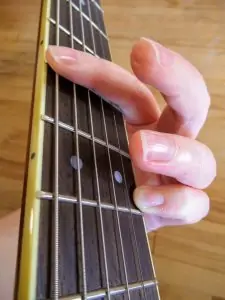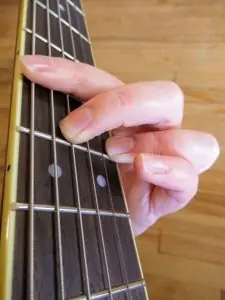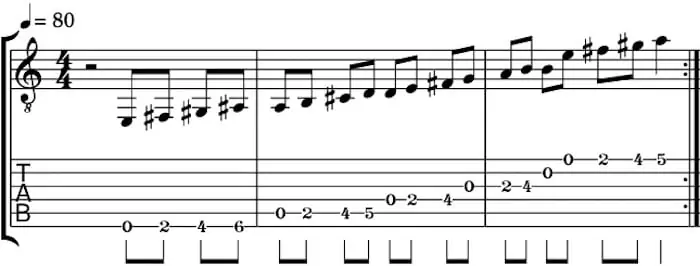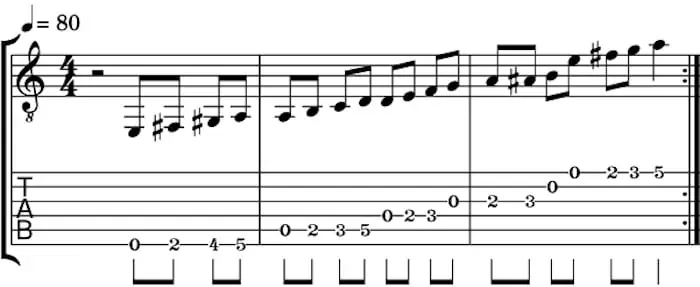Alternate tunings are some of the best ways to take your guitar playing to the next level. They can help you experiment with new chords and melodies that aren’t always possible in standard tuning.
There are hundreds of alternate tunings out there. Some, like Drop D, are widely used. Others are a bit more niche. But even these niche tunings can be versatile, if you get creative.
Orkney tuning falls into this niche category. Ironically, it has nothing to do with Orkney itself –– a chain of islands off the north coast of Scotland. It’s simply a name invented by Steve Baughman, a folk guitarist who popularized this decades-old tuning on his YouTube channel.
Orkney tuning has a Celtic-style charm that makes it perfect for a Scottish Burns Night (or even an Irish St Patrick’s Day) jam session.
Most of the time, you’ll hear Orkney tuning used by solo acoustic fingerstyle players. But it works equally well with chord progressions. If you’re feeling adventurous, you can even adapt it to electric guitar with a clean amp setting. This way, you can still get those strong, open-string drones without too much feedback.
This guide will get you started by introducing you to some essential chords, scales and practice songs in Orkney tuning.
Contents
First Things First
First off, let’s learn how to Orkney tune your guitar. We’ll also look at what sets it apart from other tunings and how you can use this strange combination of notes to your advantage.
How to tune
A standard-tuned guitar contains the following notes from the 6th to 1st strings –– EADGBE. An Orkney-tuned guitar, on the other hand, has these notes –– CGDGCD.
If you’re a 5-string banjo player, you might recognize this as sawmill tuning, but with an added low C.

Here’s a breakdown of the changes from standard tuning:
- 6th string: downtuned two whole steps
- 5th string: downtuned one whole step
- 4th string: stays the same
- 3rd string: stays the same
- 2nd string: uptuned one half step
- 1st string: downtuned one whole step
Some guitar players, like Led Zeppelin’s Jimmy Page, prefer a different variation –– DGCGCD. This can be helpful if you want to shift the tonal center (the note that feels like “home”) from C to D. But CGDGCD is the most widely used form of Orkney tuning.
Orkney is one of the few alternate tunings where you need to uptune as well as downtune strings. Normally, I’d advise against uptuning guitar strings, because it’s easy to accidentally snap them. But as long as you carefully tighten the tuning peg little by little, you should be able to reach that 2nd string C without any breakage.
As with many alternate tunings, it may take a while for your guitar neck to adjust to this new balance of tension across the strings. Just be patient and re-tune as needed. Eventually, it will settle down.
Because the 6th string C is much lower than your standard E, you may notice some fret buzz once you start playing. If so, you might want to raise the action of your guitar (the distance between the fretboard and the strings at the 12th fret). This way, you can press harder on the 6th string and still maintain a clear, foghorn-esque sound.
In some alternates, I recommend switching string gauges from lights to mediums to eliminate potential fret buzz. This usually works if all or most of your strings are downtuned. But lighter gauge strings are actually better for uptuning, because it reduces this risk of breakage.
If you can, I would stick with light gauge strings for Orkney tuning. Or, you can switch to medium lights. These hybrid packs contain medium gauges on the 6th-4th strings and light gauges on the 3rd-1st strings. It’s the best of both worlds!
Why these notes?
You might wonder why Orkney tuning uses such a strange combination of notes. It doesn’t descend or ascend evenly from standard tuning. So, what’s going on here?
It may not look like it. But Orkney is actually a type of open tuning. Most of these tunings produce a major or minor chord when you strum all 6 open strings. For example, Open G (DGDGBD) produces a G major chord, while Open C (CGCGCE) produces a C major.
Note that major chords contain scale degrees (notes) 1, 3 and 5 from their respective major scales, while minor chords contain the 1, ♭3 and 5. For example, a C chord takes the notes C, E and G notes from the C major scale (C D E F G A B), while a G chord takes the notes G, B and D from the G major scale (G A B C D E F♯ G). To transform these into minor chords, you would need to turn C major’s E note to an E♭ and G major’s B note to a B♭.
What does this have to do with Orkney tuning? Well, it has the root (1) and 5 of both G and C major. But it doesn’t contain the 3 of either one. Instead, it produces suspended (sus) versions of these chords, based on scales degrees 4 and 2 respectively. These chords are called Gsus4 (GCD) and Csus2 (CDG).
Although they contain the exact same notes, these two chords have different tonal centers. This means that a root position (root note on the bass string) Gsus4 has a slightly different sound to a root position Csus2. For example, when you strum the 6th-1st strings in Orkney tuning, this sounds more like a Csus2. However, if you strum the 5th-1st strings, it sounds more like a Gsus4. Regardless, Orkney can technically be called either Open Csus2 or Open Gsus4 tuning.
Because they lack the natural 3rd of major chords and the ♭3rd of minor chords, sus chords have an uncertain, slightly dissonant sound. But this means that they can fit easily into both major or minor keys. This major/minor flexibility gives Orkney an edge over open major tunings, where it’s often difficult to play minor chords.
Of course, the easiest keys to play in Orkney tuning are C major, C minor, G major and G minor. But you can always shift these tonal centers with a capo. For example, placing a capo on the 2nd fret would create an open Dsus2/Asus4 chord. This makes it easier to play songs in the keys of A or D.
Common Chords
Oftentimes, the exact same chord from standard tuning can sound completely different in an alternate tuning. This may be frustrating, if you want to capture a particular sound of a C, Em or Gsus4. But this can also be a great way to experiment with common chord progressions and make them your own.
Fortunately, you can play most basic chords in Orkney tuning as moveable voicings with either a 6th- or 5th-string root note. You can also try out some open chord voicings for a unique Orkney flavor.

Moveable chords
Before you start learning moveable chord shapes, it’s important to memorize the notes on your new 6th and 5th strings. This way, you’ll always know where to find the root note of a chord.
The 5th string (G) is the easiest of the two. It contains the exact same notes as the 3rd string G in standard tuning. Or, you can think of the notes you’d play on a standard A string, but shift everything up 2 frets. For example, in standard tuning, you would play a C note on the 3rd fret. In Orkney, you would play it on the 5th fret.
The 6th string (C) is a bit trickier. You’ll need to think of the notes you’d play on a standard low E string, but shift everything up 4 frets. For example, in standard tuning, you would play a G note on the 3rd fret. In Orkney, you would play it on the 7th fret.
As you probably guessed, moveable sus chords are the easiest to play. For a sus2, simply barre across all 6 strings with your index finger, using the 6th string as your root note. For a sus4, barre across the 5th-1st strings, using the 5th string as your root note.

Moveable sus2 (left) and sus4 (right) chords.
The nature of Orkney also makes it easy to play understated, jazzy “mu chords”. Coined by Steely Dan’s Walter Becker, these are similar to sus2s, but with scale degree 3. They’re easiest to play as a 6th-root barre chord, with your little finger two frets higher on the 1st string.
Moveable mu chord.
Not crazy about the sus or mu sound? Don’t worry. Major and minor chords are also a piece of cake…
- Major chord (6th-string root): full barre across all 6 strings. Add your ring finger two frets higher on the 4th string and little finger two frets higher on the 1st string.
- Minor chord (6th-string root): full barre. Middle finger one fret higher on the 4th string and ring finger one fret higher on the 1st string.
- Major chord (5th-string root): middle finger on the 5th string, ring finger on the same fret of the 4th string and little finger on the same fret of the 3rd string. Index finger 1 fret lower on the 2nd string. Muted 6th and 1st strings.
- Minor chord (5th-string root): same as the major chord, but with the index finger 2 frets lower on the 2nd string.


Moveable 6th-root major (top left), 6th-root minor (top right), 5th-root major (bottom left), and 5th-root minor (bottom right) chords.
You can also play major, minor and diminished (minor with a ♭5) chords as stripped-down triads (3-note chords) on the 3rd-1st strings. You can either play them with the root note on the 3rd string (at the same fret position as 5th-root chords) or 2nd string (at the same position as 6th-root chords).
3rd string-root triads are called root position triads, while 2nd string-root triads are called 1st inversion triads. This refers to the fact that the bass note is scale degree 5, followed by the 1 and the 3.
Here are the triad voicings:
- Major triad (root position): index finger on the 3rd string and ring finger on the same fret of the 1st string. Middle finger one fret lower on the 2nd string.
- Minor triad (root position): same as major, but with the middle finger two frets lower on the 2nd string.
- Diminished triad (root position): ring finger on the 3rd string. Index two frets lower on the 2nd string. Middle finger one fret lower on the 1st string.
- Major triad (1st inversion): middle finger on the 2nd string and index on the same fret of the 3rd string. Little finger two frets higher on the 1st string.
- Minor triad (1st inversion): same as the major triad, but with the ring finger one fret higher on the 1st string.
- Diminished triad (1st inversion): middle finger on the 2nd string. Index one fret lower on the 3rd string. Ring finger one fret higher on the 1st string.

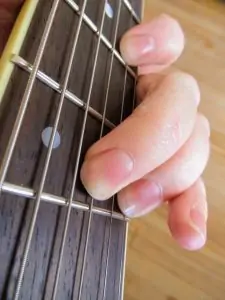


Moveable root-position major triad (top left), root-position minor triad (top center), root-position diminished triad (top right), 1st-inversion major triad (bottom left), 1st-inversion minor triad (bottom center), and 1st-inversion diminished triad (bottom right).
Many players like to experiment with wildcard chords by taking a simple moveable shape and playing the other strings open. If you remove the index barre from your 6th-root major, you can create some interesting C chords. For example, at the 3rd fret, it forms a Csus4 (CGFGCF). At the 6th fret, it’s a C5 (CGGGCG). At the 9th fret, it’s a C7(no3) (CGB♭GCB♭) –– a C7 without scale degree 3. And so on.
Another cool option is to place one finger on the 6th string and another on the same fret of the 3rd string. At the 2nd fret, this forms a D7sus4 (DGDACD). At the 4th fret, it’s an Em7♭6 (EGDBCD). And so on. Playing around with this shape lends well to “mindless New Age noodling”, as Steve Baughman calls it.

Moveable wildcard chord shapes, option 1 (left) and 2 (right). Note that option 1 always produces a C-root chord, while option 2 has a moveable root on the 6th string.
Some other useful moveable chords include:
- 6th-root power chords (5s): barre across the 6th and 5th strings. Option: add your ring finger two frets lower for the octave (root note at a higher frequency).
- 5th-root power chords: barre across the 5th and 4th strings. Option: barre across the 3rd string too for the octave.
- 6th-root 7ths (dominant 7ths): barre across the 6th-2nd strings (mute the 1st string). Ring finger two frets higher on the 4th string. Little finger three frets higher on the 3rd string.
- 5th-root 7ths: ring finger on the 5th string. Little finger on the same fret of the 4th string. Index finger two frets lower on the 3rd string. Middle finger one fret lower on the 2nd string. Rest muted.
- 5th-root major 7ths: same as the 7th, but with the middle finger one fret lower on the 3rd string.
- 5th-root half-diminished 7ths (minor 7th ♭5s): little finger on the 5th string. Ring finger one fret lower on the 4th string. Index two frets lower on the 3rd string. Middle finger two frets lower on the 2nd string. Rest muted.
- 6th-root add9s: full barre. Middle finger two frets higher on the 4th string.




Moveable 6th-root power chord with octave (top left), 5th-root power chord with octave (top center), 6th-root 7th (top right), 5th-root 7th (middle left), 5th-root maj7th (middle center), 5th-root m7th♭5 (middle right) and 6th-root add9 (bottom left) chords.
Open chords
For open chords, the most logical place to start is by treating the nut as an index barre and adding the moveable voicing beneath it. This can help you play many C chords, like C major (from the 6th-1st strings: 002002) and Cmu (000002). But this is just the tip of the iceberg.
On his YouTube channel, Steve Baughman details several open chords. These include:
- “Basic C”: C5, played on all 6 strings. 055005
- “High C”: another C5. 00(10)00(10)
- Cmaj: 055045
- Cm: 055035
- C7: actually C7(no3). 055305
- “California New Age C”: Cmaj7(no3) –– without scale degree 3. 055405
- Cadd9: 055040
- “California New Age G”: Gmu(no5). 005405
- G: x00025
- G7: x00023
- “Quasi Am”: Am7. x22002
- “D neutral”: D5. xx0220
- Dm: xx0223
It would take forever to discuss the complete list from the Big Book of Orkney Tuning Chords and other sources. But some other open chord voicings you might come across include…
- Am: x22202
- Bm: xx0424
- D: xx0224
- Em7: x42020
- F: xx3203
- Fm: xx3103
- F7: xx3201
- Fmaj7: xx3202
- G: x00420
- Gm: x00320
- G5: x00020
Common Scales
One of the downsides with Orkney tuning is that it’s difficult to play scales starting on the 6th string. Instead, I find it easier to play the tonic (scale degree 1) on the 5th string. As you create your own licks, you can always add a 6th-string walkup.
Let’s say we’re working with a basic I IV V progression in the key of C. This would include a C chord (I), F chord (IV) and G chord (V). To keep it simple, let’s stay in open position –– using (mostly) the 1st-5th frets.
The C major scale is difficult to play in open position. So instead, let’s try G major –– the perfect scale for soloing over the V chord. You can either start on the open 5th string or add a 4-5-6-7 walkup from the 6th string.
The G major scale (with a 4-5-6-7 walkup), ascending.
Technically, you can play a major pentatonic scale by removing scale degrees 4 and 7 from the major scale. Or, you can play a minor pentatonic scale by removing scale degrees 2 and ♭6 from a natural minor scale (which contains scale degrees 1 2 ♭3 4 5 ♭6 ♭7 from the major scale). But I wouldn’t recommend either pentatonic scale for Orkney tuning. After all, scale degrees 2 and 4 are essential to the sus chords that play an iconic role in the Orkney sound. Cutting them out entirely would seem too jarring.
However, one alternate scale that’s incredibly useful is Mixolydian mode. This is similar to a major scale, but replaces scale degree 7 with a bluesy ♭7.
G Mixolydian mode (with a 4-5-6-♭7 walkup), ascending.
Mixolydian mode is based on scale degree 5 of the major scale. In G Mixolydian, the parent scale is C major (C D E F G A B). Because of this close relationship, a Mixolydian scale with the tonic on the 5th string can replace a major scale with the tonic on the 6th string. For example, G Mixolydian can be used to solo over the I chord (C) in a key of C progression.
For a cool minor feel, you can transform a basic major scale into Dorian mode by by replacing scale degrees 3 and 7 with ♭3 and ♭7.
G Dorian mode (with a 4-5-6-♭7 walkup), ascending.
Dorian mode is based on scale degree 2 of the major scale. In G Dorian, the parent scale is F major (F G A B♭ C D E). This makes G Dorian an ideal choice for soloing over the IV (F) chord in our key of C progression.
Of course, you don’t have to limit yourself to the key of C. To play any of these scales with a different tonic, simply slide the pattern up the fretboard to the corresponding 5th-string root note.
Practice Songs
Orkney tuning is a bit of a strange one. Chords and scale patterns aside, its basic structure is unlike any other guitar tuning.
For one thing, it shares common notes with the banjo. For another, the 2nd and 1st strings (C and D) are only one whole step apart. This gives it a harp-like quality, especially when the two strings are played as unisons (same note) or major 2nd (one whole step apart) intervals.
Because of these banjo and harp similarities, the most widely played genres (and subgenres) are folk, Celtic and bluegrass. But this doesn’t mean that you can’t push the boundaries by experimenting with blues, jazz, indie rock or modern country.
To start off, I would recommend playing simple three- or four-chord songs in the key of C or G. Just until you get comfortable locating different chord voicings. For example, you could play…
- “Down On The Corner” by Creedence Clearwater Revival (Chords: C, F, G)
- “Royals” by Lorde (Chords: G, C, D)
- “Kumbaya” (African American spiritual) (Chords: C, F, G)
- “Loch Lomond” (Scottish traditional) (Chords: G, Am, C, D, Em)
I’d also recommend checking out the original Orkney practice tune –– Steve Baughman’s “The Orkney Song”.
“The Orkney Song” is an easy piece that can help you experiment with open chord voicings.
Once you’ve mastered the basic chords, it’s time to start learning some proper Orkney melodies. Some popular song choices include:
- “Danny Boy” by Frederic Weatherly: based on the traditional Irish melody “Londonderry Air”, this 20th-century English ballad is a popular funeral song. But the bright melody and touching lyrics keep it from being too depressing.
- “Santa Cruz” by Martin Simpson: folk guitarist Martin Simpson is probably the best known user of Orkney tuning. Once you’ve mastered “Santa Cruz”, you can try out his more advanced songs.
- “Miss MacDermott / The Princess Royal” by Turlough O’Carolan: this classic Irish harp song works surprisingly well on guitar.
Although “Danny Boy” can be played in standard guitar tuning, it sounds especially powerful with the loud, drony open strings in Orkney tuning.
You can also play any sawmill-tuned clawhammer banjo song in Orkney tuning. Aside from modern bluegrass, this includes traditional tunes like:
- Shady Grove
- Pretty Polly
- Cluck Old Hen
- Little Sadie
Final Thoughts
If this is your first time venturing out of standard tuning, then Orkney may seem intimidating. After all, the chord voicings and scales are very different to what you’re used to.
But at the heart of it, it’s no different from learning any other alternate tuning like Open D or DADGAD (open Dsus4). In fact, Orkney has several advantages over other open tunings.
Unlike open majors or minors, it’s easy to play songs in both major and minor keys. And unlike DADGAD, which has only one tonal center, it’s easy to shift the Orkney tonal center to either a C or a G. This makes it an accessible option for players who want to try an alternate tuning for the first time.
Even if you’re not into Celtic folk tunes or bluegrass-inspired clawhammer guitar, Orkney tuning is surprisingly flexible. You can experiment with different chords and scale licks to give it a blues, jazz or indie feel. The possibilities are (nearly) endless!
Have fun experimenting with this new tuning. You never know what cool chord progression or fingerstyle melody you might discover.



